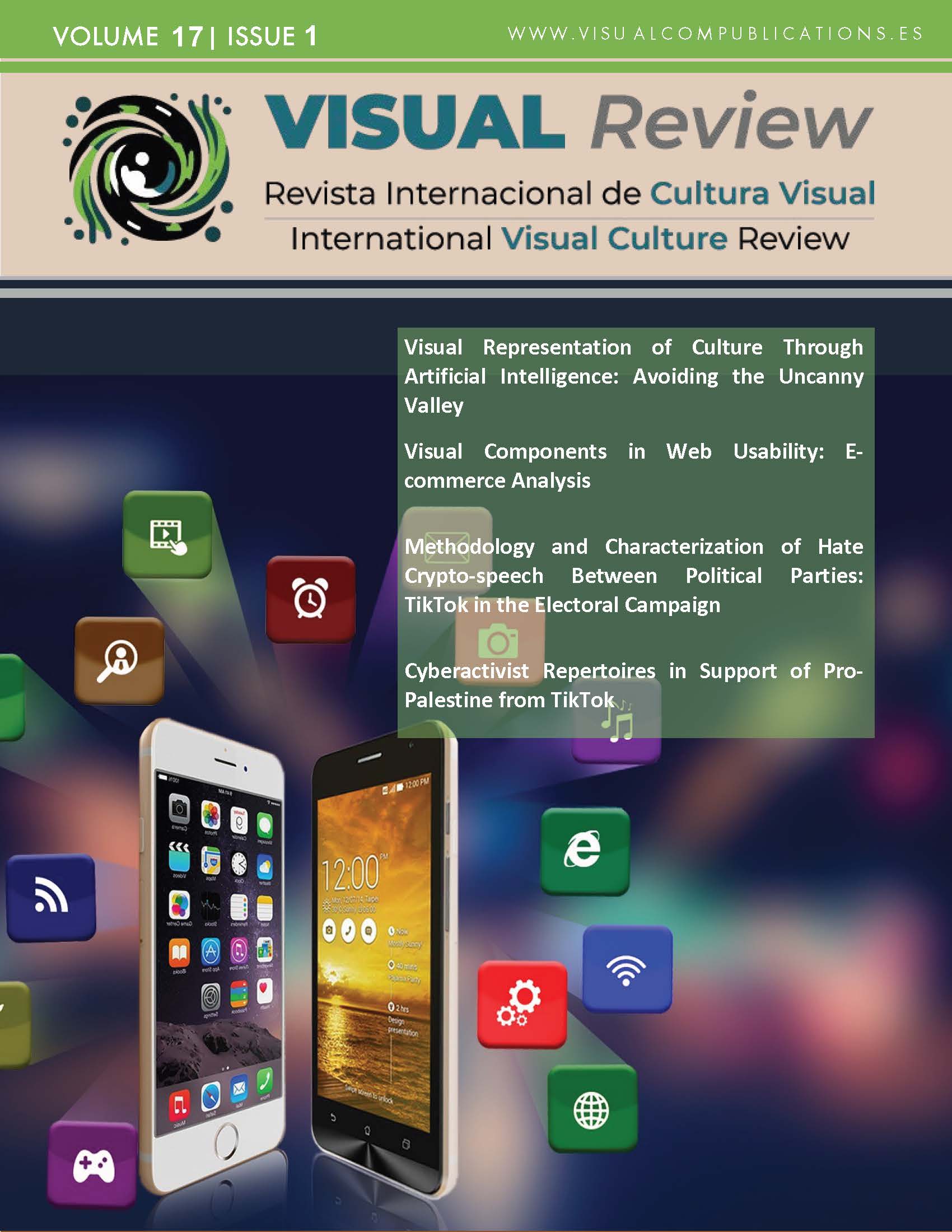Analyzing the Parenthood of Artificial Children in Fiction Films
Chappie & A.I. Artificial Intelligence
DOI:
https://doi.org/10.62161/revvisual.v17.5331Keywords:
Artificial Intelligence, Parenting, Artificial Childhood, Development Psychology, Attachment Theory, Movie analysis, AI MovieAbstract
Cinema has long reflected social opinions on topics like Artificial Intelligence. Analyzing sequences from Chappie (2015) and A.I. Artificial Intelligence (2001), a discourse analysis examined parenthood through developmental psychology, focusing on attachment theory, parenting styles, post-adoption circumstances, and child characteristics. The films show varied discourses: attachment styles are mostly secure and dismissive-avoidant, while parenting styles are generally authoritarian with nuances. Post-adoption circumstances and child characteristics significantly influence the relationship between parents and the artificial child. Society views the development of AI towards self-awareness positively and even expects it to happen.
Downloads
Global Statistics ℹ️
|
778
Views
|
567
Downloads
|
|
1345
Total
|
|
References
Abidin, R. R. (1995). Parenting Stress Index Professional Manual (3rd ed.). Psychological Assessment Resources. https://lc.cx/oTSm0S
Abusch, D. (2022). A Possible-Worlds Construal of Unreliability in Film [ВОЗМОЖНЫЕ МИРЫ ИСТОЛКОВАНИЯ НЕНАДЕЖНОСТИ ФИЛЬМОВ]. Epistemology and Philosophy of Science, 59(2), 38–42. https://doi.org/10.5840/EPS202259218 DOI: https://doi.org/10.5840/eps202259218
Ainsworth, M. D. S., & Bell, S. M. (1970). Attachment, Exploration, and Separation: Illustrated by the Behavior of One-Year-Olds in a Strange Situation. Child Development, 41(1), 49–67. https://doi.org/10.2307/1127388 DOI: https://doi.org/10.1111/j.1467-8624.1970.tb00975.x
Atzil, S., Gao, W., Fradkin, I., & Barrett, L. F. (2018). Growing a social brain. Nature Human Behaviour, 2(9), 624–636. https://doi.org/10.1038/s41562-018-0384-6 DOI: https://doi.org/10.1038/s41562-018-0384-6
Baden, A. L. (2016). “Do You Know Your Real Parents?” and Other Adoption Microaggressions. Adoption Quarterly, 19(1), 1–25. https://doi.org/10.1080/10926755.2015.1026012 DOI: https://doi.org/10.1080/10926755.2015.1026012
Bartholomew, K., & Horowitz, L. M. (1991). Attachment Styles Among bung Adults: A Test of a Four-Category Model. In Journal of Personality and Social Psychology 61(2). DOI: https://doi.org/10.1037//0022-3514.61.2.226
Bastawrous, A., & Cleland, C. (2022). Artificial intelligence in eye care: a cautious welcome. Community Eye Health Journal, 35(114), 13–13. https://lc.cx/X9vucs
Bateman, J., & Schmidt, K. H. (2013). Multimodal Film Analysis: How Films Mean. In L. , O. Kay (Ed.), Multimodal Film Analysis: How Films Mean (1st Edition). Taylor and Francis. https://doi.org/10.4324/9780203128220 DOI: https://doi.org/10.4324/9780203128220
Batty, C. (2014). Costume as Character Arc: How Emotional Transformation is Written into the Dressed Body. In C. Batty (Ed.), Screenwriters and Screenwriting: Putting Practice into Context (1st ed., pp. 80–94). Palgrave Macmillan. https://doi.org/10.1057/9781137338938 DOI: https://doi.org/10.1057/9781137338938_6
Baumrind, D. (1966). Effects of Authoritative Parental Control on Child Behavior. Child Development, 37(4), 887–907. https://doi.org/10.2307/1126611 DOI: https://doi.org/10.1111/j.1467-8624.1966.tb05416.x
Baumrind, D. (1971). Current patterns of parental authority. Developmental Psychology, 4(1, Pt.2), 1–103. https://doi.org/10.1037/h0030372 DOI: https://doi.org/10.1037/h0030372
Bell, S. M., & Ainsworth, M. D. S. (1972). Infant Crying and Maternal Responsiveness. Child Development, 43(4), 1171–1190. https://doi.org/10.2307/1127506 DOI: https://doi.org/10.1111/j.1467-8624.1972.tb02075.x
Bernays, E. L. (1928). Manipulating Public Opinion: The Why and The How. American Journal of Sociology, 33(6), 958–971. https://doi.org/10.1086/214599 DOI: https://doi.org/10.1086/214599
Blomkamp, N. (2015, March 6). Chappie. Columbia Pictures, Sony Pictures Releasing.
Bornstein, M. H., & Zlotnik, D. (2008). Parenting Styles and their Effects. In M. M. Haith & J. B. Benson (Eds.), Encyclopedia of Infant and Early Childhood Development (pp. 496–509). Academic Press. https://doi.org/10.1016/B978-012370877-9.00118-3 DOI: https://doi.org/10.1016/B978-012370877-9.00118-3
Bordwell, D., & Thompson, K. (2013). EBOOK: Film Art: An Introduction (10a ed.). McGraw Hill.
Bovenschen, I., Hornfeck, F., & Kappler, S. (2023). Relations between Children’s and Parents’ Behavior in Adoptive Families – A Longitudinal Analysis. Adoption Quarterly, 26(4), 364–388. https://doi.org/10.1080/10926755.2023.2198520 DOI: https://doi.org/10.1080/10926755.2023.2198520
Bowlby, J. (1969). Attachment and loss. Vol. I: Attachment. (2nd ed., Vol. 1). Basic Books. https://lc.cx/lCx8pz
Bowlby, J. (1973). Attachment and loss. Vol. 2: Separation: anxiety and anger. (Vol. 2). Basic Books.
Bowlby, John. (1988). A secure base: Parent-child attachment and healthy human development. Basic Books. https://lc.cx/rqgx7b
Butler, E. A., & Randall, A. K. (2013). Emotional coregulation in close relationships. Emotion Review, 5(2), 202–210. https://doi.org/10.1177/1754073912451630 DOI: https://doi.org/10.1177/1754073912451630
Chepinchikj, N., & Thompson, C. (2016). Analysing cinematic discourse using conversation analysis. Discourse, Context and Media, 14, 40–53. https://doi.org/10.1016/j.dcm.2016.09.001 DOI: https://doi.org/10.1016/j.dcm.2016.09.001
Chisholm, J. S. (1996). The evolutionary ecology of attachment organization. Human Nature, 7(1), 1–37. https://doi.org/10.1007/BF02733488 DOI: https://doi.org/10.1007/BF02733488
Choi, H., Ko, E., & Megehee, C. M. (2014). Fashion’s role in visualizing physical and psychological transformations in movies. Journal of Business Research, 67(1), 2911–2918. https://doi.org/10.1016/j.jbusres.2012.06.002 DOI: https://doi.org/10.1016/j.jbusres.2012.06.002
Davydova, O. (2022). THE CINEMA THAT DOES NOT RERPRESENT. Logos (Russian Federation), 32(5), 271–286. https://doi.org/10.22394/0869-5377-2022-5-271-285 DOI: https://doi.org/10.22394/0869-5377-2022-5-271-285
Deater-Deckard, K. (1998). Parenting stress and child adjustment: Some old hypotheses and new questions. Clinical Psychology: Science and Practice, 5(3), 314–332. https://doi.org/10.1111/j.1468-2850.1998.tb00152.x DOI: https://doi.org/10.1111/j.1468-2850.1998.tb00152.x
Eisenberg, N., Zhou, Q., Spinrad, T. L., Valiente, C., Fabes, R. A., & Liew, J. (2005). Relations Among Positive Parenting, Children’s Effortful Control, and Externalizing Problems: A Three-Wave Longitudinal Study. Child Development, 76(5), 1055–1071. https://doi.org/10.1111/j.1467-8624.2005.00897.x DOI: https://doi.org/10.1111/j.1467-8624.2005.00897.x
Eldridge, R. (2014). How Movies Think: Cavell on Film as a Medium of Art. Estetika: The Central European Journal of Aesthetics, 51(1), 3–20. https://doi.org/10.33134/EEJA.113 DOI: https://doi.org/10.33134/eeja.113
Fern, J. (2020). Polysecure: Attachment, Trauma and Consensual Nonmonogamy. Thorntree Press.
Figuero Espadas, J. (2019). A review of scene and sequence concepts. Communication & Society, 32(1), 267–277. https://doi.org/10.15581/003.32.37829 DOI: https://doi.org/10.15581/003.32.1.267-277
Gagliardi, M. (2021). How Our Caregivers Shape Who We Are: The Seven Dimensions of Attachment at the Core of Personality. Frontiers in Psychology, 12, 1–22. https://doi.org/10.3389/fpsyg.2021. 657628 DOI: https://doi.org/10.3389/fpsyg.2021.657628
Gagliardi, M. (2022). Human attachment as a multi-dimensional control system: A computational implementation. Frontiers in Psychology, 13, 1–27. https://doi.org/10.3389/fpsyg.2022.844012 DOI: https://doi.org/10.3389/fpsyg.2022.844012
Gagliardi, M. (2024). The role of developmental caregiving programming in modulating our affiliation tendency and the vulnerability to social anxiety and eating disorders. Frontiers in Psychology, 14, 1–19. https://doi.org/10.3389/fpsyg.2023.1259415 DOI: https://doi.org/10.3389/fpsyg.2023.1259415
Gao, D., Liu, J., Bullock, A., Li, D., & Chen, X. (2021). Transactional models linking maternal authoritative parenting, child self-esteem, and approach coping strategies. Journal of Applied Developmental Psychology, 73, 1–8. https://doi.org/10.1016/j.appdev.2021.101262 DOI: https://doi.org/10.1016/j.appdev.2021.101262
Gerlach, J., Fößel, J. M., Vierhaus, M., Sann, A., Eickhorst, A., Zimmermann, P., & Spangler, G. (2022). Family risk and early attachment development: The differential role of parental sensitivity. Infant Mental Health Journal, 43(2), 340–356. https://doi.org/10.1002/imhj.21964 DOI: https://doi.org/10.1002/imhj.21964
Harlow, E. (2019). Attachment theory: developments, debates and recent applications in social work, social care and education. Journal of Social Work Practice, 35(1), 79–91. https://doi.org/ 10.1080/02650533.2019.1700493 DOI: https://doi.org/10.1080/02650533.2019.1700493
Hesse, E., & Main, M. (2000). Disorganized Infant, Child, and Adult Attachment: Collapse in Behavioral and Attentional Strategies. Journal of the American Psychoanalytic Association, 48(4), 1097–1127. https://doi.org/10.1177/00030651000480041101 DOI: https://doi.org/10.1177/00030651000480041101
Hruby, R., Hasto, J., & Minarik, P. (2011). Attachment in integrative neuroscientific perspective. Neuro Endocrinology Letters, 32(2), 111–120. https://lc.cx/H7sQU-
Hu, S., Packard, K., & Opendak, M. (2022). Social Regulation of Negative Valence Systems During Development. In Frontiers in Systems Neuroscience 15, 1–8. https://doi.org/10.3389/fnsys. 2021.828685 DOI: https://doi.org/10.3389/fnsys.2021.828685
IMDb. (n.d.-a). A.I. Artificial Intelligence. https://lc.cx/lHSYL5
IMDb. (n.d.-b). Chappie. https://lc.cx/TgV7Ws
Janney, R. (2012). Pragmatics and Cinematic Discourse. Lodz Papers in Pragmatics, 8(1), 85–113. https://doi.org/10.1515/LPP-2012-0006 DOI: https://doi.org/10.1515/lpp-2012-0006
Jones, J. D., Cassidy, J., & Shaver, P. R. (2015). Parents’ Self-Reported Attachment Styles: A Review of Links with Parenting Behaviors, Emotions, and Cognitions. Personality and Social Psychology Review, 19(1), 44–76. https://doi.org/10.1177/1088868314541858 DOI: https://doi.org/10.1177/1088868314541858
Kressierer, D., K. (1996). Adoption as deviance: Socially constructed parent‐child kinship as a stigmatized and legally burdened relationship. Deviant Behavior, 17(4), 39-415. https://doi.org/10.1080/01639625.1996.9968037. DOI: https://doi.org/10.1080/01639625.1996.9968037
Lerner, R. M. (2018). Concepts and Theories of Human Development. Routledge. https://doi.org/10.4324/ 9780203581629 DOI: https://doi.org/10.4324/9780203581629
Lin, X., Yang, W., Xie, W., & Li, H. (2023). The integrative role of parenting styles and parental involvement in young children’s science problem-solving skills. Frontiers in Psychology, 14, 1–9. https://doi.org/10.3389/fpsyg.2023.1096846 DOI: https://doi.org/10.3389/fpsyg.2023.1096846
Lupton, D. (1992). Discourse analysis: a new methodology for understanding the ideologies of health and illness. Australian Journal of Public Health, 16(2), 145–150. https://doi.org/10.1111/J.1753-6405.1992.TB00043.X DOI: https://doi.org/10.1111/j.1753-6405.1992.tb00043.x
Maccoby, E. E., & Martin, J. A. (1983). Socialization in the Context of the Family: Parent-Child Interaction. In P. H. Mussen & E. M. Hetherington (Eds.), Handbook of Child Psychology: Vol. 4. Socialization, Personality, and Social Development 4, 1–101.
Macmull, M. S., & Ashkenazi, S. (2019). Math anxiety: The relationship between parenting style and math self-efficacy. Frontiers in Psychology, 10(1721), 1–12. https://doi.org/10.3389/fpsyg.2019.01721 DOI: https://doi.org/10.3389/fpsyg.2019.01721
Main, M., & Hesse, E. (1990). Parents’ Unresolved Traumatic Experiences Are Related to Infant Disorganized Attachment Status: Is frightened and/or frightening parental behavior the linking mechanism? In M. T. Greenberg, D. Cicchetti, & E. M. Cummings (Eds.), Attachment in the Preschool Years: Theory, Research, and Intervention (pp. 161–182). The University of Chicago Press.
Main, M., & Solomon, J. (1986). Discovery of an Insecure-Disorganized/Disoriented Attachment Pattern. In T. B. Brazelton & M. W. Yogman (Eds.), Affective Development in Infancy (pp. 95–124). Ablex Publishing Corporation.
Mazzeschi, C., Pazzagli, C., Radi, G., Raspa, V., & Buratta, L. (2015). Antecedents of maternal parenting stress: The role of attachment style, prenatal attachment, and dyadic adjustment in first-time mothers. Frontiers in Psychology, 6, 1–9. https://doi.org/10.3389/fpsyg.2015.01443 DOI: https://doi.org/10.3389/fpsyg.2015.01443
McGinnis, H. A., & Wright, A. W. (2023). Adoption and child health and psychosocial well-being. In Encyclopedia of Child and Adolescent Health, First Edition (Vol. 2, pp. 582–598). Elsevier. https://doi.org/10.1016/B978-0-12-818872-9.00115-1 DOI: https://doi.org/10.1016/B978-0-12-818872-9.00115-1
Mikulincer, M., & Shaver, P. R. (2009). An attachment and behavioral systems perspective on social support. Journal of Social and Personal Relationships, 26(1), 7–19. https://doi.org/10.1177/ 0265407509105518 DOI: https://doi.org/10.1177/0265407509105518
Moe, V., von Soest, T., Fredriksen, E., Olafsen, K. S., & Smith, L. (2018). The multiple determinants of maternal parenting stress 12 months after birth: The contribution of antenatal attachment style, adverse childhood experiences, and infant temperament. Frontiers in Psychology, 9, 1–14. https://doi.org/10.3389/fpsyg.2018.01987 DOI: https://doi.org/10.3389/fpsyg.2018.01987
Nasiriavanaki, Z., Barbour, T., Farabaugh, A. H., Fava, M., Holmes, A. J., Tootell, R. B. H., & Holt, D. J. (2021). Anxious attachment is associated with heightened responsivity of a parietofrontal cortical network that monitors peri-personal space. NeuroImage: Clinical, 30, 1–11. https://doi.org/10.1016/j.nicl.2021.102585 DOI: https://doi.org/10.1016/j.nicl.2021.102585
National Collaborating Centre for Mental Health (UK). (2015). Introduction to children’s attachment. In Children’s Attachment: Attachment in Children and Young People Who Are Adopted from Care, in Care or at High Risk of Going into Care. (Vol. 26, pp. 16–33). National Institute for Health and Care Excellence (NICE). https://lc.cx/wGvsrD
Newman, L., Sivaratnam, C., & Komiti, A. (2015). Attachment and early brain development – neuroprotective interventions in infant–caregiver therapy. Translational Developmental Psychiatry, 3(1), 1–12. https://doi.org/10.3402/tdp.v3.28647 DOI: https://doi.org/10.3402/tdp.v3.28647
Piazza, R., Bednarek, M., & Rossi, F. (2011). Telecinematic Discourse: Approaches to language of films and television series (Vol. 211). John Benjamins Publishing Company. https://doi.org/10.1075/ pbns.211 DOI: https://doi.org/10.1075/pbns.211
Raby, K. L., & Dozier, M. (2019). Attachment across the lifespan: insights from adoptive families. Current Opinion in Psychology, 25, 81–85. https://doi.org/10.1016/J.COPSYC.2018.03.011 DOI: https://doi.org/10.1016/j.copsyc.2018.03.011
Riger, S., & Sigurvinsdottir, R. (2015). Thematic Analysis. In L. A. Jason & D. S. Glenwick (Eds.), Handbook of Methodological Approaches to Community-Based Research (pp. 33–42). Oxford University Press. https://doi.org/10.1093/med:psych/9780190243654.003.0004 DOI: https://doi.org/10.1093/med:psych/9780190243654.003.0004
Rothbart, M. K., & Bates, J. E. (2006). Temperament. In N. Eisenberg, W. Damon, & R. M. Lerner (Eds.), Handbook Of Child Psychology Sixth Edition Volume Three: Social, Emotional, and Personality Development Editors-in-Chief (6th ed., Vol. 3, pp. 99–166). John Wiley & Sons, Inc.
Salter Ainsworth, M. D., Blehar, M. C., Waters, E., & Wall, S. (2015a). Patterns of attachment: a psychological study of the strange situation. Psychology Press. DOI: https://doi.org/10.4324/9781315802428
Salter Ainsworth, M. D., Blehar, M. C., Waters, E., & Wall, S. N. (2015b). Patterns of attachment: A psychological study of the strange situation. https://lc.cx/YFCyDe
Sameroff, A. (2009). The Transactional Model of Development: How Children and Contexts Shape Each Other (1st ed.). American Psychological Association. DOI: https://doi.org/10.1037/11877-000
Schermerhorn, A. C., & Mark Cummings, E. (2008). Transactional family dynamics: A new framework for conceptualizing family influence processes. In Advances in Child Development and Behavior (Vol. 36, pp. 187–250). Academic Press Inc. https://doi.org/10.1016/S0065-2407(08)00005-0 DOI: https://doi.org/10.1016/S0065-2407(08)00005-0
Seañez Fernández, C. G. (2022). Espacios del amor gay: representaciones de la pareja gay en el cine mexicano contemporáneo [Master Thesis, Instituto Tecnológico y de Estudios Superiores de Monterrey]. https://hdl.handle.net/11285/648759
Sheikh, H., Prins, C., & Schrijvers, E. (2023). Artifcial Intelligence: Defnition and Background. In C. Prins & F. Brom (Eds.), Mission AI: The New System Technology (pp. 15–41). Springer Cham. https://doi.org/10.1007/978-3-031-21448-6 DOI: https://doi.org/10.1007/978-3-031-21448-6_2
Singh, S., Roy, P., Sahoo, N., Mallela, N., Gupta, H., Bhattacharyya, P., Savagaonkar, M., Nidhi, Ramnani, R., Maitra, A., & Sengupta, S. (2022). Hollywood Identity Bias Dataset: A Context Oriented Bias Analysis of Movie Dialogues. Proceedings of the Thirteenth Language Resources and Evaluation Conference, 5274–5285. https://arxiv.org/abs/2205.15951v2
Small, J. W. (2013). Adopted in America: A Study of Stigma. SSRN Electronic Journal. https://doi.org/10.2139/SSRN.2280517 DOI: https://doi.org/10.2139/ssrn.2280517
Soares, J., Barbosa-Ducharne, M., & Palacios, J. (2023). Mediating Role of the Child’s Temperament on the Relationship Between Mother/Father’s Adoptive Parenting and Adoptee’s Social Skills: Hybrid Dyadic Analyses. Adoption Quarterly, 26(4), 389–413. https://doi.org/10.1080/10926755. 2023.2198522 DOI: https://doi.org/10.1080/10926755.2023.2198522
Spielberg, S. (2001, August 3). A.I. Artificial Intelligence. Warner Bros., DreamWorks Pictures, Warner Bros. Pictures.
Susa-Erdogan, G., Benga, O., Albu-Răduleț, M., & Macovei, T. (2022). Child temperament and child-teacher relationship quality: Implications for children’s emotional functioning during preschool period. Frontiers in Psychology, 13, 1–12. https://doi.org/10.3389/fpsyg.2022.992292 DOI: https://doi.org/10.3389/fpsyg.2022.992292
Thompson, R. A., Winer, A. C., & Goodvin, R. (2011). The individual child: Temperament, emotion, self, and personality. In Developmental Science: An Advanced Textbook (6th ed., p. 427). Psychology Press.
Wittig, S. M. O., & Rodriguez, C. M. (2019). Emerging behavior problems: Bidirectional relations between maternal and paternal parenting styles with infant temperament. Developmental Psychology, 55(6), 1199–1210. https://doi.org/10.1037/dev0000707 DOI: https://doi.org/10.1037/dev0000707
Zhang, L., Pan, Y., Wu, X., & Skibniewski, M. J. (2021). Artificial Intelligence in Construction Engineering and Management. 163. https://doi.org/10.1007/978-981-16-2842-9 DOI: https://doi.org/10.1007/978-981-16-2842-9
Downloads
Published
How to Cite
Issue
Section
License
Copyright (c) 2025 VISUAL REVIEW. International Visual Culture Review / Revista Internacional de Cultura Visual

This work is licensed under a Creative Commons Attribution-NoDerivatives 4.0 International License.
Those authors who publish in this journal accept the following terms:
-
Authors retain copyright.
-
Authors transfer to the journal the right of first publication. The journal also owns the publishing rights.
-
All published contents are governed by an Attribution-NoDerivatives 4.0 International License.
Access the informative version and legal text of the license. By virtue of this, third parties are allowed to use what is published as long as they mention the authorship of the work and the first publication in this journal. If you transform the material, you may not distribute the modified work. -
Authors may make other independent and additional contractual arrangements for non-exclusive distribution of the version of the article published in this journal (e.g., inclusion in an institutional repository or publication in a book) as long as they clearly indicate that the work was first published in this journal.
- Authors are allowed and recommended to publish their work on the Internet (for example on institutional and personal websites), following the publication of, and referencing the journal, as this could lead to constructive exchanges and a more extensive and quick circulation of published works (see The Effect of Open Access).













